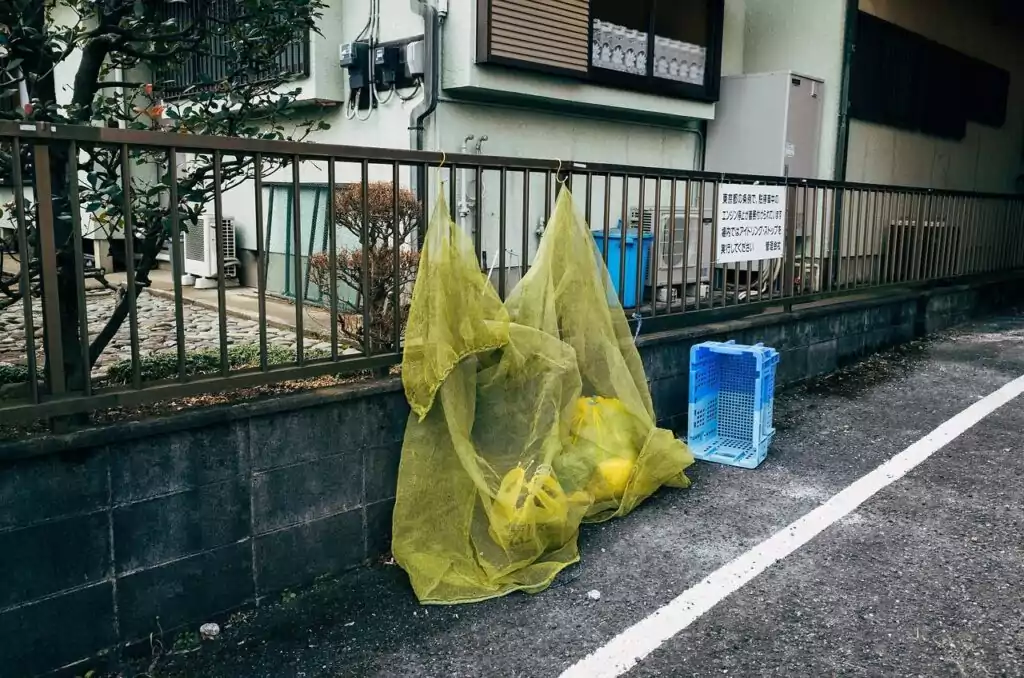In a paper published by Catharina Klein, a researcher specializing in energy, environment, and resources in Japan on Statista on May 11th, 2023, the 2021 fiscal year in Japan saw close to 41 million metric tons of waste generated in the country. 29 million metric tons of this was household waste, most of it being made up of containers and packaging materials, over half of which were plastic. Individually, the average person in Japan produces around 890g of waste per day.
When moving, the amount of waste a household accumulates and disposes of naturally and inevitably increases. In the United States, it’s estimated that 8.4 million tons of 16.8 billion pounds of junk gets thrown out every year in the name of moving. With landfills rapidly filling up and land to accommodate such services decreasing, it’s more important than ever to reduce our carbon footprint and the amount of waste we generate. When moving, households can do this by donating, giving away, or selling items they no longer want or need.
Village House apartments come unfurnished, but if you decide to rent with them, you do have the possibility to opt for “add-ons”, such as an A/C unit, stovetop, etc., for a slight increase in rent. Doing so takes away the need to purchase these items as well as having to deal with how to dispose of them in the future.
Dispose

Garbage in Japan is categorized into:
- Moeru gomi (Combustibles)
- Moenai gomi (Non-combustibles)
- Shigen gomi (bottles and cans)
- Soudai gomi (oversized trash)
Each prefecture, city, and ward may have its own rules and regulations when it comes to the disposal of waste along with different collection times and dates. When moving to a new city in Japan, it’s best to get a booklet about your local area’s trash sorting rules and collection schedule to familiarize yourself with it.
Depending on what needs to be thrown out, you may or may not have to do some prep beforehand. For example, PET bottles should be rinsed out and the labels peeled off along with their caps. They should then ideally be flattened before being put into a transparent or semi-transparent trash bag.
For juice and milk cartons, they also need to be rinsed out, dried out, and then flattened. For cardboard boxes and moving boxes, they need to be flattened and tied together with twine or rope, which can be bought for cheap at any 100-yen shop.
When it comes to disposing of unwanted household items, if they are not oversized, they will most likely be considered as non-combustibles. However, check your local area’s trash collection guidelines to see what items can and cannot be disposed of and collected as non-combustible trash.
Oversized household items need to be collected by a special trash collection agency, which will be explained more in the next paragraph.
Junk Collection Service

Japan is rather notorious for having a strict and complex waste sorting and disposal system, which can differ depending on prefecture, city, and ward. Oversized garbage such as furniture, bicycles, household appliances, electronics, etc., is also known as soudai gomi in Japan. These waste items can be picked up and disposed of for a fee, which comes in the form of stickers (soudai gomi shori ken) that can be purchased at convenience stores. The process can be quite tricky and time-consuming, especially if you’re not quite fluent in Japanese because depending on where you live, you either have to call to make an appointment for the item to be picked up, or you can make arrangements on your ward or city’s official website.
Alternatively, there are numerous private junk and waste removal companies throughout Japan; and if you are on a budget, some places to look for these services online include Craigslist and Facebook.
If you specifically have household appliances and electronics you want to get rid of, ReNet Recycle is a Japanese company specializing in the removal, disposal, and recycling of e-waste. It costs ¥1,500 per box (¥1,650 with tax) but the service, which includes pick-up at your designated address, is free if the box includes a computer.
Recycle Shops

There is a growing movement in Japan where thrifting and secondhand goods are gaining in popularity. One of the biggest secondhand chains in Japan is the “OFF” brand of secondhand stores, some of which include Book Off, Mode Off, Hobby Off, and Hard Off.
Thrift shops known as furugiya in Japanese, are also plentiful around Japan, especially in the big cities and if you live in the Tokyo and Saitama areas, King Family Recycle Shop and Cosmo Space Recycle Shop are secondhand stores you can venture to for secondhand clothing, accessories, and furniture.
If you want to sell or donate unwanted or unneeded items, the aforementioned recycle shops operate similarly in that you simply bring the item(s) you want to sell into one of their shops for inspection by one of their staff members. You will usually get a waiting number and when your number is called, they will provide you with an estimate; and if you are happy with the amount offered, they will collect your items and pay you in cash. If you simply want to donate items, check their website to see what can and cannot be donated.
How to Sell on Mercari Japan

Mercari is a Japanese e-commerce company and online marketplace app established in 2013. It is currently Japan’s largest online community-run marketplace website and app with over JPY 10 billion in transactions carried out every month. It’s a great way to reduce waste and earn a bit of extra pocket money on items you no longer want or need.
Mercari works in a similar fashion to eBay and Yahoo! Auctions – simply sign up for an account and start posting ads for items you want to sell.
When it comes to pricing your items, browse through similar listings to gauge how much your item(s) are selling for. Remember that Mercari takes 10% of your final price in the form of a handling fee so try not to undersell your item too much.
Pictures are recommended to get more hits and buyers. Each item is allotted a maximum of 4 images so take pictures of your items against a white backdrop if possible in good light. Try to get pictures of your item from a few different angles for transparency.
You can also minimize questions and inquiries about your items by providing a detailed product description with the following:
- Brand name
- Item type and model name or number
- Size and color
- Material and measurements
The condition of your item is also very important. On Mercari, the conditions of an item fall into the following categories:
- New /unused – the item is still in its original packaging or still has its tags
- Slightly used – the item has only been used a maximum of a handful of times and has no visible wear and tear
- Good – the item has been used but there are no visible wear and tear and/or cosmetic imperfections
- Has wear and tear – the item has been used and has some visible wear and tear and/or cosmetic imperfections
Shipping your item is fairly simple on Mercari as they partner with Japan Post. There are a few shipping options depending on the size and weight of your item. YuYu Mercari is a shipping option that can be used for items up to 170cm while Rakuraku Mercari can be used to send oversized items such as furniture, so long as they are a maximum of 200cm in length and within 30kg. For smaller items, you can take it to the nearest convenience store to pay for and post it.
The downside to Mercari is that is it currently only in the Japanese language so if you are not quite fluent in Japanese, some alternative online marketplaces that non-Japanese residents frequently use include Craigslist and Facebook.
Moving Company
Some moving companies in Japan double as removal service agencies and depending on what you need to dispose of, they may either take it from you for free, or for a fee. You may be able to get a discount if you employ their moving services or depending on which moving company you choose, you may be able to do a swap or trade – handing in items you no longer want or need in exchange for previously owned item(s) that the moving company has from a previous mover.
Some real estate agencies such as Village House also provide move-in support, where you can get up to ¥30,000 cashback so if you are looking to dispose of unwanted household items and furniture, talk with one of their representatives on how to do so.
Related articles:
- I Can’t Finish Packing! What Should I Do?
- Stress-Free Moving: Essential Tips for Packing Like a Pro!
- Reselling in Japan
- What Do You Need to Clean Before Moving Out?



